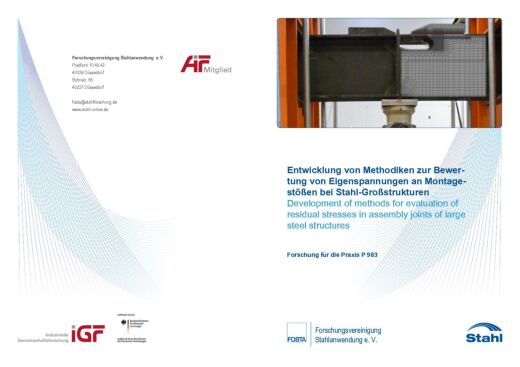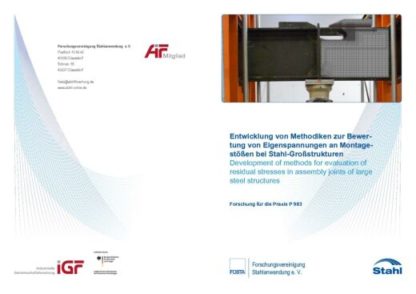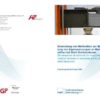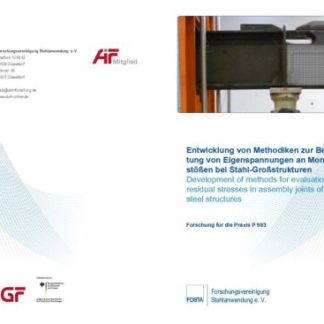Description
P 983 – Development of methods for evaluation of residual stresses in assembly joints of large steel structures
Fatigue assessment of welded structures in the steel construction and shipbuilding industry or crane construction is still affected by uncertainties. One reason is the influence of residual stresses and deformations caused by the welding process. These effects can be reduced e.g. by adopting appropriate welding procedures and techniques or welding sequences. But when it comes to welding of assembly joints between large components or sections e.g. in shipbuilding, conventional welding techniques and inaccuracies can cause high deformations and residual stresses. These negatively affect the strength and fatigue properties and can require expensive straightening treatments. To effectively influence welding induced deformations and residual stresses by changing boundary conditions and welding sequences or post-weld treatments, knowledge of the expected deformations and stresses is required. Another aspect is the influence of residual stresses on the fatigue of welded structures. The International Institute of Welding (IIW) recommends a reduction of the permissible stress level depending on the boundary conditions to consider detrimental residual stresses. In some cases, where the stabilized residual stress distribution is not well known, this may lead to over-conservative fatigue evaluations.
Measurement of residual stresses generally involves expensive and complex experimental setups and is not practicable in most cases. Calculation of residual stresses by means of Finite Element simulations is also possible. This usually involves a thermal simulation of the heat input, followed by a structural simulation resulting in deformations and stresses. These calculations still need calibration and verification by experimental data and involve temperature dependent material properties which are generally not available. Because of nonlinearities calculations are rather complex and time consuming. Application on large structures is limited by complex modelling, simulation time and the availability of powerful hardware. Alternatively simplified calculation methods can be adopted to evaluate residual stresses and deformations. Thereby accuracy is reduced and different methods can lead to different results, implying uncertainties in the valuation of the calculated stress. This calls for a practicable approach to calculate welding induced residual stresses.
In the present project residual stresses are investigated experimentally and numerically (SYSWELD, ANSYS) for an assembly joint of a web frame corner which is common in shipbuilding. These specimens included two typical weld geometries, cruciform joint and longitudinal stiffener. Specimens in two scales have been tested. Calculation results are verified by X-ray residual stress measurements. Furthermore, finite element analyses were used to examine simplified approaches of residual stress calculations. Fatigue tests on as welded and on stress-relieved specimens were carried out in order to determine the influence of residual stresses experimentally. At the cruciform joint the measurements yielded comparable results although the number of weld layers varied. At the longitudinal stiffener results differed between the two scales due to the different plate thicknesses which affected cooling rates and the geometry of the welds. Repeated measurements after cyclic loading showed that residual stress redistribution took place during the first load cycle.
Fatigue tests in as-welded and stress-relief heat-treated conditions showed no clear residual stress influence on the fatigue life of the investigated welds. Residual stresses might have affected the crack initiation at both, cruciform joint and longitudinal stiffener.
However, stress concentration in the weld toes of longitudinal stiffeners was rather high, and thus, responsible for component failure.
Comparison between calculated and measured residual stresses showed good agreement, provided that phase transformation effects were taken into account.
Only available in german language.
Published in:
August 2016
Authors:
N. Pagel, J. Klassen, W. Fricke, J. Friedrich
FOSTA – Research Association for Steel Application




